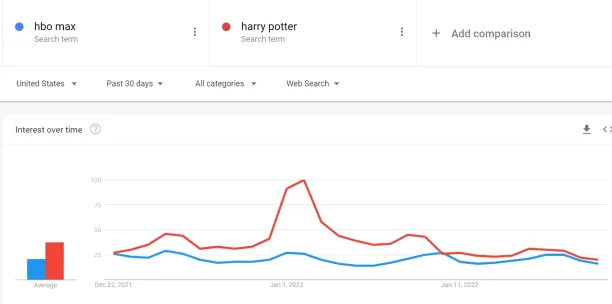Web scraping enables many decision-making processes to become more data-driven. Especially in marketing, web scraping has numerous applications, but the variety of use cases can also make it more challenging to gauge which ones apply for your business and would be more beneficial.
This article highlights the top marketing use cases that web scraping made possible or improved significantly, and give examples for each one of them.
1. Watch your competitors’ performance:
Before the rise of digital marketing, TV ads were the ultimate marketing battle ground for many brands. There were commercial breaks between TV shows and all TV channels reported their ratings from a standard measurement provider. At the end, all brands knew how much they were watched in comparison to each other as based on a comparable metric.
Challenge
In the digital world, channels are very diverse and there is not one number to track the competitor’s success. When your competitor launches a new product, they can start a hashtag campaign on social media, appear in sponsored news articles, work with multiple influencers across all mediums. This brings a complicated competitive landscape to detect your competitor’s presence in and gather data from.
Solution
Web scraping tools allow you to target a set of keywords and collect as much content as you want from the internet that those keywords appear in. If you choose keywords such as the name of your competitor product, the brand ambassador they work with or the hashtags they promote in their campaigns on social media about that brand can be all reported to you.
With this data, you can summarize how often they received engagement on social media, analyze the sentiment of what people said when they mentioned that brand.
To learn how to to scrape social media networks, check out “Social Media Scraping: Tools, How-to & Case Studies“.
For example, let’s imagine you work for an online content platform, and you want to know how your competitor’s recent show is doing. How did HBO Max’ Harry Potter Reunion perform, which can be considered as a new product launch in digital content world?
As seen on Figure 1, searches for “Harry Potter” were surged when it was launched while searches for HBO Max was rather stable. Apart from it, your questions remain unanswered.
- Did people like the show?
- Is there a big drop after the launch because people thought it wasn’t worth watching?
- Did HBO Max build more awareness about its content portfolio?
- Did people mention about HBO Max or other content on the platform more after the launch of Harry Potter Reunion?
If you search for “Harry Potter Reunion” on the internet to check it out, good luck with reading tens of news articles and thousands of tweets about it. Alternatively, you can scrape top web pages and tweets that has “Harry Potter” in it from a specific date range and analyze which words appeared in the content.

For example, as seen on Figure 2, one of three tweets below found the show boring. The other two liked the show. Only one mentioned HBO Max. When you analyze thousands of such posts, you’ll reveal the big picture about the show and answer your questions without necessarily accessing the data HBO Max has for their own traffic.

2. Find the right brand message and ambassadors:
Influencer marketing becomes a top priority for many businesses’ marketing strategy.
Challenge
One challenge of influencer marketing is that it requires continuous effort from businesses to stay on top of latest trends about their customers. Which topics do they talk about? Which influencers get more popular over time? Answers to these questions constantly change. Therefore, businesses need an up to date source of reference to reflect the public opinion and web scraping is the fundamental tool to achieve that.
Solution
Web scraping enables businesses to search for keywords related to their brands and scrape what people posted about these on social media. These posts reveal insights about:
- New hashtags to use in brand’s own social marketing
- Newly emerging influencers that may be less costly to work with
- New concepts people associate with your brand or that product type
For example, let’s say you want to launch an influencer marketing campaign for your brand but you have limited budget. You want to find small-scale influencers who may accept gift products as compensation.
Let’s say you heard a few names. How do you check whether those influencers have worked with a similar brand or their values do not contradict with your brand? With web scraping, you can target keywords related to your brand and scrape the web for the most trending social media posts, filter the data for accounts with a certain number of following and have a short list to start with.
3. Unlock 360° brand analytics:
Digital ad measurement can give very detailed information about your paid ads. You can track the actual performance of your ads behind the overall traffic they get, such as whether they stayed on the viewer’s screen long enough to be noticed, whether the traffic came from a bot or human and if human, whether they were from your target audience or not.
Challenge:
Your brand has more digital presence than you control with paid ads. Monitoring this presence is not easy. Did a reputable source provide links to your brand that you want to promote? On the contrary, is your brand receiving bad publicity on social media that you want to address? Even worse, are there fake accounts imitating your brand to reach out to your customers?
Solution
The only way to know what content is out there about your brand is to actually scan the web to find relevant content to your brand. Web scraping unlocks the analytics of your web presence created by others with below two capabilities:
- Collect backlinks: Web scraping can target websites to alert you whenever your website is referred by them. Especially if you generate a big amount of content, this data can give you additional insight about which content performs better and gives you a chance to re-share the sources mentioned you.
- Brand protection: Just like tracking certain metrics for marketing campaigns’ success, brands should also adopt a “brand safety” tracking to make sure that the brand is not impersonated by a fake account or placed in an inappropriate content. While brands’ online presence grow, ways to damage a brand through copyright infringement or ad fraud become more sophisticated and often difficult to detect. Web scraping plays the role of a lighthouse, scanning the web for where your brand appears and detects suspicious sources for your review. Read our detailed posts about brand protection and copyright infringement to learn more about how brand protection works and real life examples.
Further Reading
For more on the latest technology trends in marketing, check out our research in:
- Top 8 Marketing Automation Trends (with case studies)
- Social Media Scraping: Tools, How-to & Case Studies
- How to Scrape Instagram and 6 Best Instagram Scrapers
If you believe that your business may benefit from a web scraping solution, check our list of web crawlers to find the best vendor for you.
For guidance to choose the right tool, reach out to us:
This article was drafted by former AIMultiple industry analyst Bengüsu Özcan.

Comments
Your email address will not be published. All fields are required.